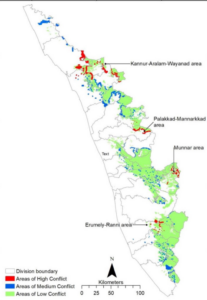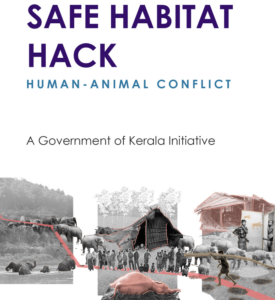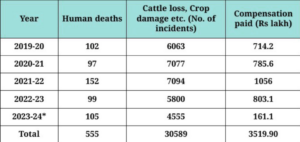The Wildwatch app, launching by mid-January, aims to streamline conflict resolution and reduce risks to humans and animals. Developed under Forest-PLUS 3.0, a collaboration between MoEFCC and USAID, it enhances data-driven, sustainable forest management
Published Jan 06, 2025 | 10:00 AM ⚊ Updated Jan 06, 2025 | 10:00 AM

First in Kerala’s history: Man-eater tiger ordered to be killed (Kerala Tourism)
Kerala is embracing technology to tackle the escalating issue of human-wildlife conflict (HAC), aiming to transform its mitigation strategies with advanced tools, real-time alert systems, and integrated solutions.
One of the state’s most ambitious initiatives, the Wildwatch app, is set to roll out by mid-January, promising to streamline conflict resolution and minimise risks to both human and animal populations.
Developed under the Forest-PLUS 3.0 programme—a collaboration between the Ministry of Environment, Forest and Climate Change (MoEFCC), Government of India, and the United States Agency for International Development (USAID)—the app marks a significant step towards data-driven and sustainable forest management.
The Wildwatch app, created by Kerala Startup Mission-registered Leopard Tech Labs, uses cutting-edge Geographic Information System (GIS) technology to manage wildlife conflicts effectively.
It enables citizens to report wildlife sightings in human-inhabited areas by uploading GPS-tagged photographs through their smartphones.

Wildwatch APP
Reports are sent instantly to the nearest Forest Division Emergency Operations Centre (FDEOC), where officials verify the information and assess the severity of the situation.
If deemed a high-priority threat, such as a potential human-wildlife confrontation, notifications are automatically relayed to the Rapid Response Task Forces (RRTs) and relevant forest divisions, including headquarters.
These automated processes ensure swift and coordinated action.
“The system follows a structured protocol,” a senior forest department official told South First.
“Upon receiving a report, the app asks a series of questions to assess the threat level. High-alert incidents are prioritised and verified at multiple levels before response teams are mobilised. Updates on the resolution process, from ‘ongoing’ to ‘completed,’ are dynamically tracked in the app.”
To avoid duplication, submissions are cross-checked before being logged, and final verification is conducted by forest department personnel.
The app is currently undergoing trial runs in HAC hotspots like Wayanad, Palakkad, Thrissur, Pathanamthitta, and Thiruvananthapuram.

conflict areas in the forest divisions of Kerala
While forest officials are the primary users during this phase, the Wildwatch app is expected to become publicly available by the second week of January, after additional testing.
The app’s developers have prioritised data security and compliance with state data regulations.
For individuals without access to smartphones, the system will integrate alternative reporting methods such as SMS and phone calls.
Calls to the FDEOC will be processed similarly, ensuring no gaps in communication.
According to the Forest Department, Wildwatch app is just one component of Kerala’s broader vision to create technology-driven mitigation measures for managing HAC.

from Wildwatch app
“Earlier, there was only the SARPA app, which focuses on snake rescues. But with this app, we could rescue / mitigate HAC incidents involving elephants and other animals,” said a forest personnel.
It is also learnt that the department envisions a single, integrated platform to regulate and streamline operations.
While public notifications about ongoing incidents are currently disabled in the Wildwatch app to prevent panic, this feature may be introduced later.
At the same time, Kerala is turning to technology-driven solutions to tackle the escalating human-wildlife conflict (HWC) that threatens lives and livelihoods in forest-adjacent areas.
In a marked departure from traditional methods, the Kerala Development and Innovation Strategic Council (K-DISC) has announced the “Safe-Habitat Hack,” a hackathon aimed at developing innovative strategies to address this pressing issue.

safe habitat hack
While traditional methods like solar-powered fences, elephant-proof trenches, and compensation for crop loss remain in place, their effectiveness is often hampered by terrain challenges, maintenance issues, and species-specific behaviours.
For instance, solar fences fail to deter monkeys, while trenches are ineffective in fragmented landscapes.
It is learnt that the state aims to integrate advanced technologies such as real-time monitoring systems, GPS-enabled alerts for barrier breaches, and IoT-based sensors near human settlements.
Enhanced tools like thermal cameras and AI-powered animal movement trackers will improve early warning systems and targeted interventions.
Recognising that community acceptance is critical, the government also plans to involve local stakeholders in the design and implementation of solutions.
Furthermore, animal-specific mitigation protocols are being developed for species like elephants, tigers, and wild boars, addressing diverse challenges like crop raids and livestock attacks.
In short, Kerala’s innovative approach to managing human-wildlife conflict marks a significant leap towards more effective and sustainable solutions.
With the rollout of the Wildwatch app, powered by advanced GIS technology and AI tools, the state is addressing the escalating threats of human casualties, crop destruction, cattle lifting, and property damage caused by wildlife.

human deaths and damage to cattle and crops in animal attacks in Kerala
It is said that HAC remains a serious challenge across nearly all forest divisions, particularly in the northern region, where it jeopardises both biodiversity conservation and natural resource management.
The state’s plan to integrate real-time monitoring systems, community involvement, and animal-specific mitigation strategies is expected to set a promising example of how technology can foster coexistence between humans and wildlife.
(Edited by Ananya Rao)
